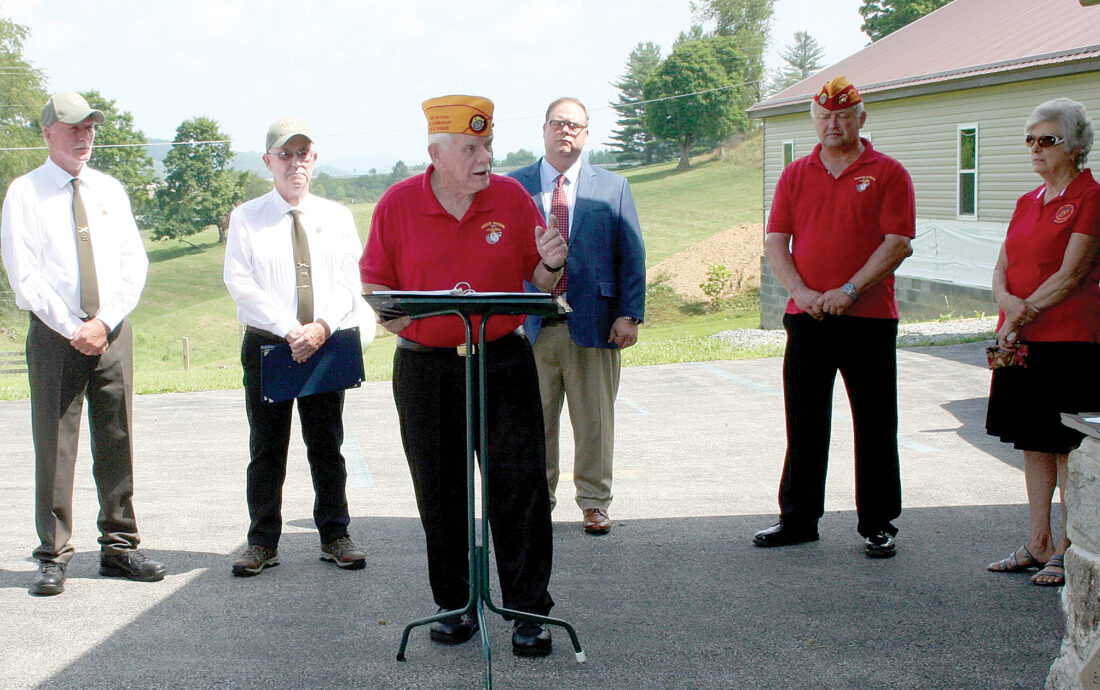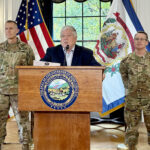Hero Honored
Bridge renamed for Randolph soldier
- Submitted photos Elkins Marine Corps League Commandant Roger Ware, foreground, who has been instrumental in efforts to rename Randolph County bridges for servicemen killed in action, delivers remarks during Saturday’s ceremony to rename the Stalnaker Run Bridge near Gilman as the U.S. Army PFC Donald L. Stuckey Memorial Bridge. Participating in the ceremony were, left to right, U.S. Army veterans Keith Williams and Charlie Gear, House of Delegates member William “Ty” Nestor (R-66th District), and MCL members Greg Irwin and Judy Gum.
- House of Delegates member William ‘Ty’ Nestor, R-66th District, right, displays a miniature sign similar to those flanking the ends of the U.S. Army PFC Donald L. Stuckey Memorial Bridge. Assisting at the ceremony commemorating renaming the bridge are U.S. Army veterans Keith Williams, left, and Charlie Gear, center.

Submitted photos Elkins Marine Corps League Commandant Roger Ware, foreground, who has been instrumental in efforts to rename Randolph County bridges for servicemen killed in action, delivers remarks during Saturday’s ceremony to rename the Stalnaker Run Bridge near Gilman as the U.S. Army PFC Donald L. Stuckey Memorial Bridge. Participating in the ceremony were, left to right, U.S. Army veterans Keith Williams and Charlie Gear, House of Delegates member William “Ty” Nestor (R-66th District), and MCL members Greg Irwin and Judy Gum.
GILMAN — He fought in agonizing freezing weather and on exceedingly rough terrain, dying nearly 72 years ago of injuries sustained in one of the most brutal battles of the Korean War.
Now a bridge near his childhood home bears the name of the 19-year-old Randolph County soldier who lost his life in service to his country.
The U.S. Army PFC Donald L. Stuckey Memorial Bridge is the span formerly known as the Stalnaker Run Bridge at the intersection of U.S. 291 north and Stalnaker Run Road near the Gilman community. Approval for renaming the bridge in Stuckey’s memory was granted this year by the West Virginia Legislature and a ceremony to mark the change was held Saturday in the parking lot outside the nearby Refuge Church.
Elkins Marine Corps League Commandant Roger Ware, instrumental in efforts to name local bridges in memory of Randolph County servicemen killed in combat, served as master of ceremonies for the bridge renaming ceremony.
Ware said the newly renamed bridge is small, “yet will serve as a constant reminder of who Donald Lee Stuckey was.”

House of Delegates member William ‘Ty’ Nestor, R-66th District, right, displays a miniature sign similar to those flanking the ends of the U.S. Army PFC Donald L. Stuckey Memorial Bridge. Assisting at the ceremony commemorating renaming the bridge are U.S. Army veterans Keith Williams, left, and Charlie Gear, center.
Born in Elkins on Aug. 13, 1931, Stuckey attended the eight-year Stalnaker Run School and then while attending Elkins High School, “he rode a school bus countless times over the bridge now named in his honor,” Ware said. “On Stalnaker Run he grew up into a young man who loved life and his family and eventually joined the U.S. Army answering his country’s call when it sent a United Nations force to Korea in 1950 to counter North Korea’s invasion across the 38th parallel.”
Stuckey, a private first class, served as a light weapons infantryman with the U.S. Army’s 27th Infantry Regiment, 25th Infantry Division. On Nov. 27, 1950, the Chinese Army surprised United Nations Forces at the Chosin Reservoir, resulting in a brutal 17-day battle in sub-freezing weather on rough terrain.
Also known as the Chosin Reservoir Campaign, the Battle of Chosin Reservoir was a decisive action during the Korean War. Between Nov. 27, 1950, and Dec.13, 1950, 30,000 United Nations troops were encircled and attacked by about 120,000 Chinese troops under devastating conditions, which led to 17,000 UN Forces being killed, wounded, or missing in action.
Stuckey suffered traumatic injuries at the beginning of the Chosin Reservoir battle and died of his wounds on Nov. 27, 1950. He is remembered at the Korean War Veterans Memorial in Washington, D.C., and is buried at Little Arlington Cemetery near the Cravensdale community.
For his bravery and sacrifice, Stuckey was posthumously awarded a Purple Heart Medal, Combat Infantryman Badge, Marksmanship Badge, Korean Service Medal, National Defense Service Medal, Republic of Korea Presidential Citation, Republic of Korea War Service Medal, and United Nations Service Medal.
Ware said following World War II, “our nation had become like a flock of sheep” with citizens “content when someone else was courageous enough to fight off the wolves.”
“As long as someone volunteered to stay out there protecting those within the flock, they were safe,” Ware said. “Since a few volunteers were enough to keep the wolves at bay, all those in that flock became complacent, and weren’t concerned if one of the volunteers lost his life fighting the wolves. After all, it was just one of the volunteers and not one of them, so they experienced no pain or suffering. Donald was one of the volunteers who wanted to protect the flock, so he joined the U.S. Army and was extremely proud to wear our nation’s colors.”
Elkins resident Loren Chenoweth, who as a youngster knew Stuckey’s family, worked in conjunction with West Virginia House of Delegates member William “Ty” Nestor (R-66th District) to submit House Concurrent Resolution 39 to gain approval from the West Virginia Legislature to rename the Stalnaker Run Bridge in Stuckey’s memory.
“Delegate Nestor wanted to not only memorialize PFC Stuckey’s service in this small way, but also to have it be a memorial for our society in general about the sacrifice that this individual, as well as other servicemen and servicewomen, have given to protect our independence as a country,” Ware said.
“Now as we reflect upon this fallen soldier and his great sacrifice, we recognize the naming of this bridge will serve as a lasting symbol of our remembrance,” Ware said, adding it will “ensure future generations are aware of his sacrifice in the cause of freedom.”
“It is with respect and dignity that we are here today to remember him, honor him and pledge never to forget him as this bridge will forever serve as a silent sentinel of his service,’ he said during the ceremony.
Ware said Nov. 27, 1950, is the day Stuckey’s family “would remember that Donald Stuckey forever remains 19 years old.”
“It’s been 72 years since Donald died and he was a true American hero,” Ware said. “No action or gesture can adequately express our gratitude for his service. It’s my sincere hope that his family and friends and our entire community can take pride and solace in today’s dedication, which will forever serve as a reminder of Donald’s courage and commitment to his country. The naming of this bridge is a wonderful way of remembering this brave young soldier who made the ultimate sacrifice for our country.”
For those who cross this bridge every day, the signs will serve “as a silent reminder that freedom has a price, and Donald Stuckey gave his life to help pay for this freedom,” Ware said.
“We also dedicate this memorial as a place where those coming after us will recognize our desire to acknowledge those who have sacrificed so much for our freedom and they will be encouraged to place the same importance on this site as we do here today.
“Donald was never properly honored for his sacrifice. This was long overdue,” Ware said. “He stands in the unbroken line of patriots who have dared to die that freedom might live and grow and increase its blessings. Freedom lives, and through it, he lives.”




